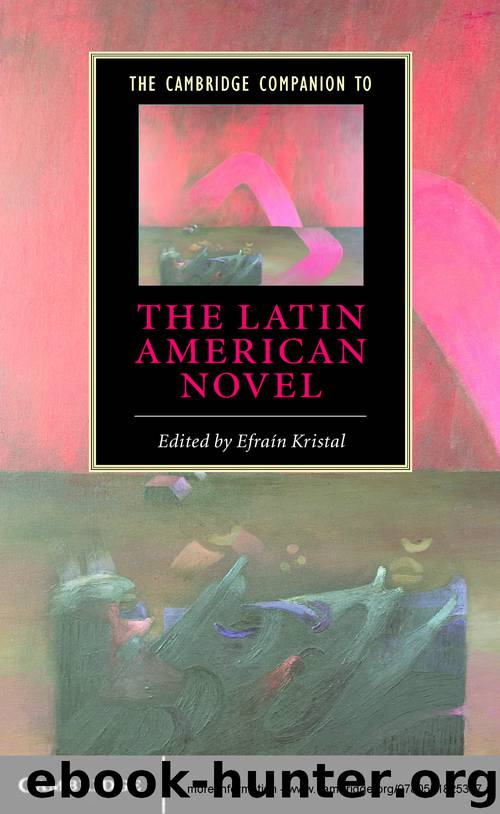The Cambridge Companion to the Latin American Novel by Unknown

Author:Unknown
Language: eng
Format: epub
Publisher: Cambridge University Press
Published: 2005-03-08T16:00:00+00:00
Costumbrismo, antiimperialismo, criollismo, and indigenismo
As the star of modernismo waxed and waned, the Central American novel explored a number of interrelated modes which, for heuristic purposes, could be labeled as costumbrismo (relating to the folkloric representation of customs and manners), antiimperialismo (attacking US hegemonic ambitions), criollismo (focusing on various aspects of national and/or regional reality), and indigenismo (defending Indian rights and culture). Whereas the plots and arguments of these novels can stir the heart of even the most cynical reader, their styles and techniques can be rudimentary. A Manichean vision – good versus evil, justice against injustice, man against nature, urban vices opposed to rural virtue – can also strike the modern reader as unsophisticated. In spite of such reservations, it is thanks to this kind of writing that the novel gradually came of age in Central America.
One of the earliest exponents of costumbrismo was Costa Rica’s Joaquín García Monge (1881–1958). His first novel, El moto (“The orphan,” 1900), written when he was only nineteen, is considered a classic in his homeland. A tale of thwarted love between a peasant lad and the local strongman’s daughter, this novel’s folksy realism features the typical language of the Costa Rican countryside, utilized to describe the landscape and customs of the campesino (peasant). Monge also published Las hijas del campo (“Daughters of the countryside,” 1900), a denser novel which moves fluently from rural to urban settings and combines folklore with social criticism. Costa Rica produced another master of costumbrismo in Manuel González Zeledón (1864–1936). Publishing under the name of Magón, he quickly became the nation’s most popular author with a prolific series of pen-portraits of nineteenth-century society. In his only novel, La propia (1911), a tragic tale of sex, betrayal, and murder in the Costa Rican coffee plantations, Magón dissects the psychology of machismo with uncanny insight.
Other Central American novelists focused upon their national realities with varying degrees of depth, range, and acuity, often utilizing regional dialects to give their fictions a sense of authenticity. In El primo (“The cousin,” 1905), Costa Rican Genaro Cardona (1863–1930) portrays the bourgeois decadence of San José. In En una silla de ruedas (“In a wheelchair,” 1916), Cardona’s compatriot Carmen Lyra (1888–1949) incorporates a strong dose of sentimentalism in a portrayal of national customs and manners through the eyes of a paralyzed artist. In El Salvador, Alberto Masferrer (1868–1932) condemns the mores of a hypocritical society which keeps women in thrall in Una vida en el cine (“A life in the cinema,” 1922), a novel based on a series of intense conversations between a man and a woman in the darkness of a cinema. Another Salvadorean, José María Peralta (1873–1944), delighted his country’s small reading public with Doctor Gonorreitigorrea (with an obvious pun on gonorrhoea), a populist satire of the nation’s bourgeoisie enthralled with foreign goods of consumption.
A harsher, overtly political outlook informed the work of many Central American novelists who responded to the historical events shaking the region. The Mexican Revolution (1910–20) opened many eyes to the oppression of the masses and the liberating potential of the armed struggle.
Download
This site does not store any files on its server. We only index and link to content provided by other sites. Please contact the content providers to delete copyright contents if any and email us, we'll remove relevant links or contents immediately.
4 3 2 1: A Novel by Paul Auster(12286)
The handmaid's tale by Margaret Atwood(7680)
Giovanni's Room by James Baldwin(7192)
Asking the Right Questions: A Guide to Critical Thinking by M. Neil Browne & Stuart M. Keeley(5644)
Big Magic: Creative Living Beyond Fear by Elizabeth Gilbert(5614)
Ego Is the Enemy by Ryan Holiday(5294)
The Body: A Guide for Occupants by Bill Bryson(4975)
On Writing A Memoir of the Craft by Stephen King(4863)
Ken Follett - World without end by Ken Follett(4645)
Adulting by Kelly Williams Brown(4487)
Bluets by Maggie Nelson(4474)
Eat That Frog! by Brian Tracy(4436)
Guilty Pleasures by Laurell K Hamilton(4362)
The Poetry of Pablo Neruda by Pablo Neruda(4041)
Alive: The Story of the Andes Survivors by Piers Paul Read(3969)
White Noise - A Novel by Don DeLillo(3954)
Fingerprints of the Gods by Graham Hancock(3942)
The Book of Joy by Dalai Lama(3903)
The Bookshop by Penelope Fitzgerald(3777)
